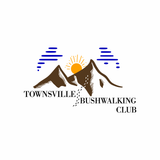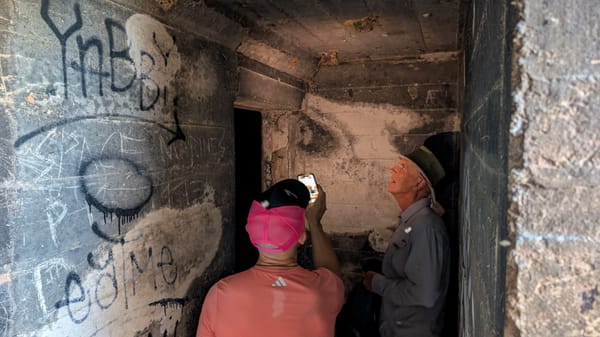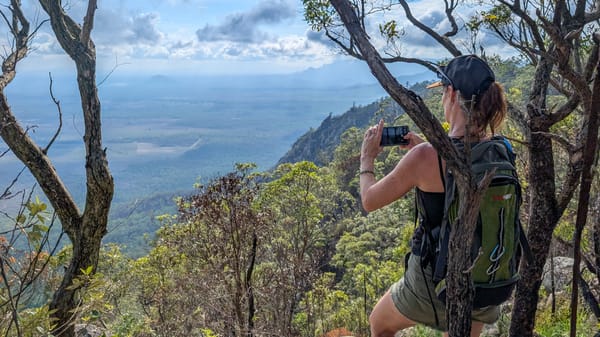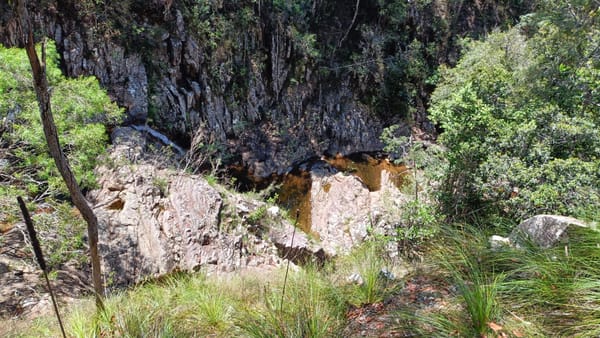Escape Magazine - July 1982
From water slides at Leichhardt Creek to muddy treks at Repulse, Easter at Cape Upstart, and sailing tales from Goold Island, July ’82 was packed with adventure, laughs, and lessons in leaving no trace.
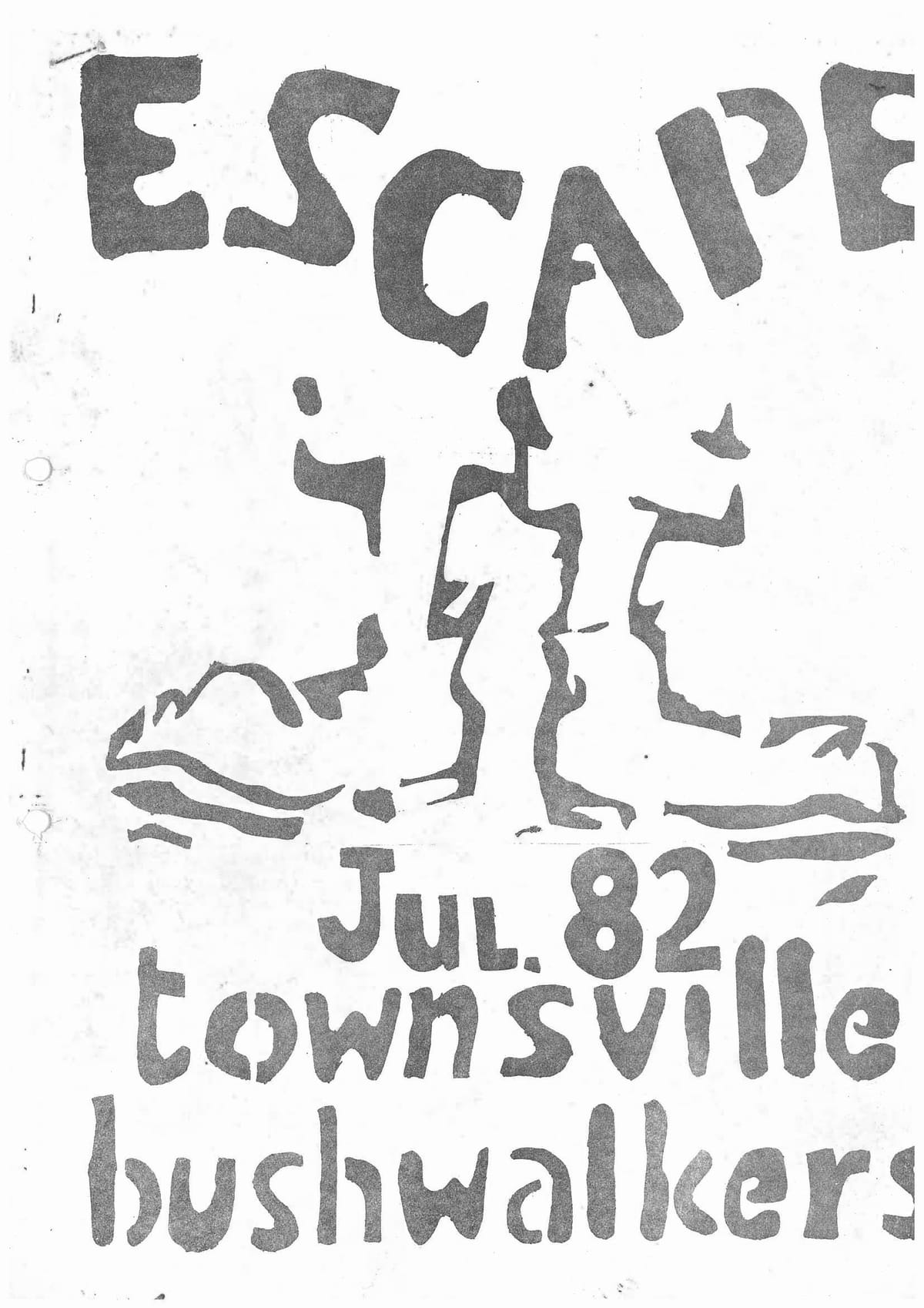
ESCAPE JUL. 82
Townsville Bushwalkers
WHO'S WHO?
PRESIDENT : Allan Watson
VICE PRESIDENT :
SECRETARY : Graeme Standfield
TREASURER : Pauline Roberts
EQUIPMENT & SAFETY TRAINING OFFICER :
EDITOR : Glynis Lee
CONTACTS.
Graeme or Pauline
Ph: 790434
Adrian Jeffries,
Townsville Environment Centre,
819 Flinders St,
Townsville, 4810.
Ph: 716226
Mail: P.O. Box 494, Townsville, 4810.
MEETINGS:
held at the Townsville Environment Centre, (next to the Pizza Sorrento, Ingham Rd end of Flinders St) at 8pm:
| Jul | Aug | Sept | Oct | Nov | Dec |
|---|---|---|---|---|---|
| 14 | 11 | 8 | 6 | 3 | 1 |
| 28 | 25 | 22 | 20 | 17 |
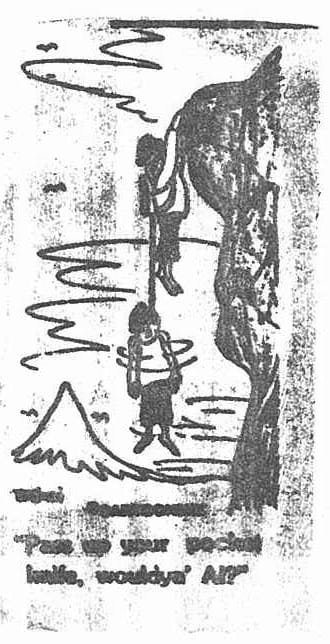
EDITORIAL
Firstly, I'd like to thank everyone involved in the making of this magazine.
Secondly, as this year has seen a rapid and continuous growth in the size of the Club, I would like extend a warm welcome to all the new members. It is certain that future walks and social events will be well supported.
Travelling on a recent trip, I was gazing at the beautiful views of the surrounding countryside as I sat crammed into a vehicle with a bunch of "Bushies" when I suddenly realised how lucky I was. Here I was about to spend the weekend in a magnificent area which few people ever see, and to top it off, with a great bunch of people. Thinking of this made me feel glad to be a part of this group.
Bushwalking makes us appreciate many things in life - things we often take for granted until there's difficulty in obtaining them - such as water, shelter, fire; the comforts of home like a hot shower and a comfortable bed; the beauty in nature and most importantly, the beauty found in each other.
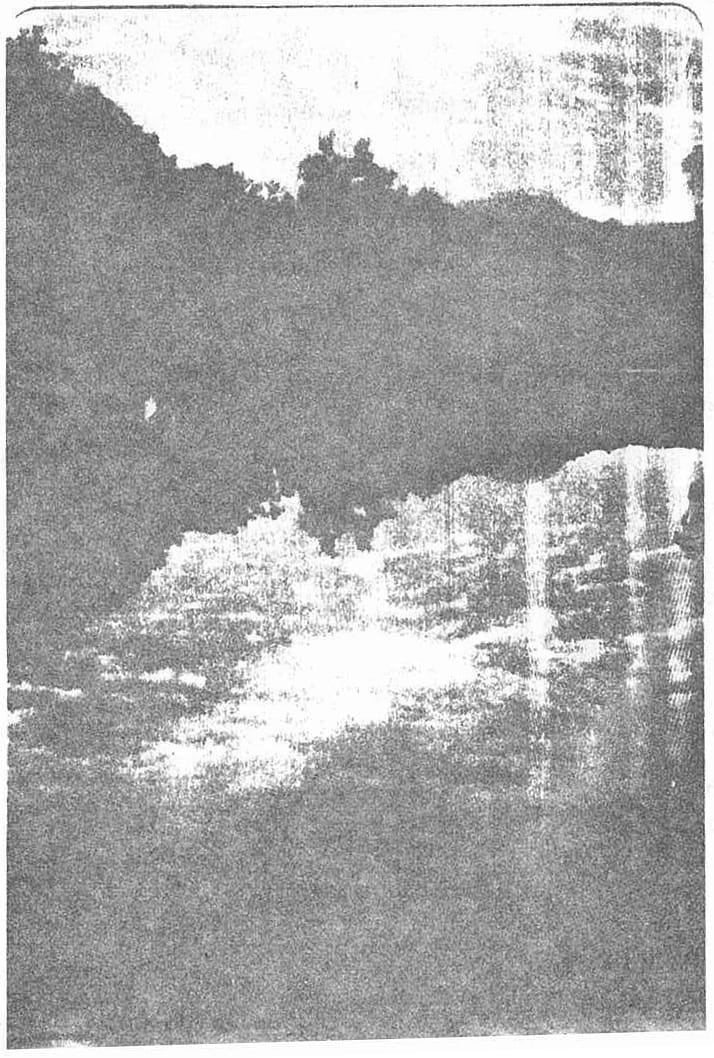
MORNING MIST
As the moon's fading
brings lightness to the
shadowed surrounds
A cool freshness pervades
the reaches of my mind
and clears the entangled
lines of yesterday's pressures.
A stillness spreads
a peaceful contentment
over the land,
and wakes the song-bird
with a gentle hand.
G.L.
DAY WALK TO LEICHHARDT CREEK
9 May 1982
A quick glance at the Provisional 1982 Programme would not reveal a day walk to Leichhardt Creek. Despite this there were no fewer than 21 starters in front of the Old Court House at 7.30 a.m.
To those passing by it was clear that this was not be your average bushwalk. Clyde had a pack which would have rivalled that of Jeff's on a normal three day walk. And Lily was armed with a 4 litre cask and 2 litre flagon of wine. This requires some explanation. Most participants had been at Lily's place the previous night for a party, and more than a couple had furry tongues that morning.
The walk started around 9.00 a.m. under Allan's leadership at the farmhouse adjacent to the creek. We had trecked for about 45 minutes through some rather unpleasant long grass when it was realised that 4 walkers were missing, all from the same vehicle. Now this may not have been a surprise if there were 2 males and 2 females, but 4 males? Clearly something was wrong. There was much discussion. Young Harry mumbled something about 4 walkers being more than 10%, and that was not on. The decision was made to have a swim until they arrived. A short time later Jock, Greg, Clyde and Jeff came walking up the creek. What was in the pack of Clyde's?
We continued along the creek until we found a nice rock pool at 10.45 a.m. While crossing a creek on her fathers back Anita Simet was heard to ask Lily whether she required assistance in crossing the creek. After a short swim, and leftovers from the party, two groups formed. One continued up the creek at a fairly quick pace to the water slide while the other was to follow a short way at a more dignified pace under Beth's leadership.
The advance party reached the slide at 12.15 after having a short swim at a deep rock pool on the way. All who reached the slide felt it was well worth the effort. After slides, lunch, and more slides it was back down the creek.
Another swim followed at the rock pool where the parties had first split. A version of the king of the Castle developed with many similarities to the Faulkland Crisis. Jim and Jock occupied a rock clearly the domain of the others and immediately a bombardment of the said rock provided with splashing from John, land to sea missiles (Jock landing on Helen), sea to land (an underwater attack by Russell) and eventually a complete landing. Boys will be boys.
The day ended back at the farmhouse at 5 p.m. with most people having enjoyed the day and agreeing that Glennis' cheesecake took the prize the previous night. We enjoyed the company of our guests Ken and Patricia who Russell John brought along. The only disappointment - we didn't find out what Clyde had in the pack. I don't believe the theory that it was a leg he had accidentally amputated at the hospital on Saturday. Although Marie is not at her best on Mondays I'm sure she would notice a missing leg from a tonsils patient.
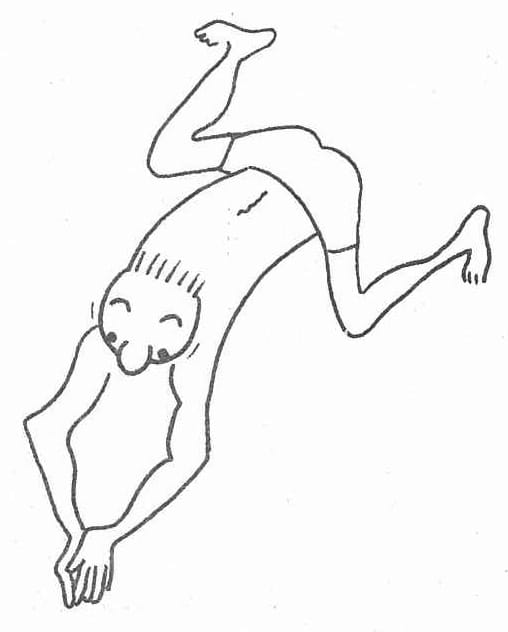
NEWS ON PEOPLE IN THE CLUB
Kathy Boulton, who is out at the Isa, recently visited Townsville.
Tony Skinner is looking for his pot of gold at Marble Bar.
Harry Kershaw is back with us wandering around the North again.
Geoff Oliver is travelling the north, still recovering from grass skiing on the Tablelands.
MIDDLE CONWAY. 31 APRIL - 3 MAY 1982. LABOUR DAY WEEKEND.
BY PAULINE ROBERTS.
My hopes were low as we set off on Friday night. It has been a day of steady rain in Townsville, and it looked as though it could turn into a weekend of the same.
Would this trip go down in history as being as unpleasant as the Conway trip of yore, still talked about by the old timers? Or should we go to the Charters Towers Country Music Festival instead?
These were my thoughts as we drove on through unslackening rain to arrive at the beginning of the forestry road. After a few missed turns (which road to Proserpine?) the entire party of cars and 13 people finally found Brandy Creek and the right road and assembled together for the night.
We left the next morning at 9.00 a.m., the rain having stopped at last, and walked along the now disused forestry road for about 10 km. The road wound through the State Forest, muddy underfoot, but enabling one to peer into the magnificent rainforest without having to walk through it.
At the morning tea stop the first of the weekend's fire-lighting epics took place, and with it the first sampling of a wide range of teas. All types, from Earl Gray to Peppermint were sampled over the weekend.
The forestry road went as far as a pine plantation (looking out of place amongst the natural vegetation) and at this point we headed for the creek, which was variously called a tributary or Repulse Creek. The most efficient way to progress down the creek was to wade through it, as the rainforest grew very closely along the banks, and the creek water was not too deep. There were the odd forays into the rainforest but, even though it had no lawyer vines it proved better to look at than to walk through.
So it was a case of becoming a wading-bird. It seems there are two varieties of these birds; - the wet-shorts and the dry-shorts - as some slippery rocks were soon encountered. Boot wearers found their footwear had to be drained periodically. The water was clear and shallow and quite pleasant to walk through; unlike the dreaded Ethel Creek which I have vivid memories of wading through.
We made our base camp at a point shortly after the tributary joined Repulse Creek. A suburban row of tents and flies lined up with their back doors close to the bank ready for a quick escape in case of a flash flood!
It had been overcast and cool all day. That night the clouds rolled away and the moon rose; while
Around the superbly-lit campfire there were some gourmet meals prepared (the usual high standards and variety were maintained).
There was no flute music, as our resident musician was not with us, but there were crocodile stories for our Canadian visitor.
Next morning (Sunday) we divided into two groups. One went downstream for the day and the other went upstream.
Both parties had a leisurely wade for several hours and returned in the afternoon.
We saw several snakes; butterflies; and colourful birds (kingfishers?) zooming in and out of the forest. Stands of very tall palm trees and the huge and contorted fig trees with umbrella trees and orchids growing from them. Now that the sun was shining, the reflections in the water became apparent. The downstream party's lunch spot (illustrated) was a deep and cold lagoon.
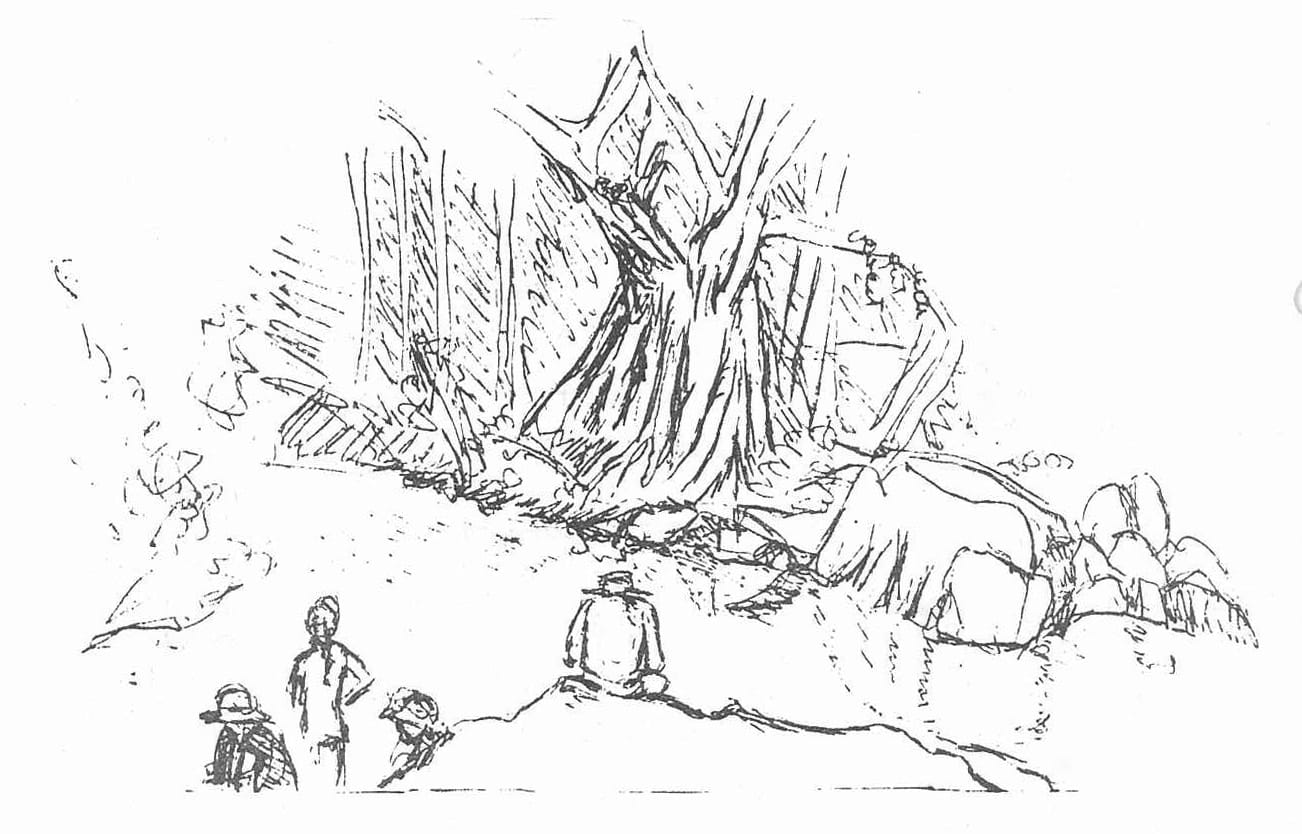
The second night was spent engaging in more gourmet delights and celebrating Jim Cameron's birthday.
On Monday, the party left at the crack of 9.00 (or was it 9.45?) to retrace our steps, up the creek (one final freezing swim), on to the forestry road, and back to the cars.
Thank you Lynn, for leading such a delightful walk.
And now, my awards for the weekend:
- For Dry shorts : Lynn Hyland
- Best Boot drainer : John Hunter
- For Non-fishing and fishing-gear destruction : Geoff Oliver
- For Creative and persistent fire-lighting : Les Hyland and Alwyn
- That Birthday Cointreau : Jim Cameron.
ONE WAY TO NOT HAVE FRESH FISH FOR BREAKFAST.
I wake up for the third time, but this time the faint light outside my tent tells me I have to decide between the warmth and comfort of my cosy sleeping bag or the opportunity to try and catch a fish for breakfast. This morning I choose, contrary to usual, to forsake my bed and brave the brisk chill of early morning to pursue those ever elusive fish. I set out, with brand new rod and reel, to try my luck at the pool just upstream.
The mist is still hovering in wisps over the still surface of the water. The birds are singing and chirping their morning chorus in the rainforest and the gurgling rapids upstream add harmony to the sound. A kingfisher flashes by, its brilliant blue and red plumage sparkles in the first rays of the sun. A majestic heron flaps slowly past flying low over the water. As I arrive at the pool a large turtle floats motionless at the surface, disappearing the instant he becomes aware of my presence. The water is crystal clear; where the sun hits the water you can see the bottom fifteen feet down. On a morning like this nothing can go wrong.
I sneak to the edge of the pool and cast over to the far side where the deepest part of the pool is still in the shadows. Waiting a few seconds to let the line sink, I start reeling in slowly. The lure snaps almost immediately. No reason to panic; from countless past snags I know that if I walk sufficiently far downstream, the change in angle will usually be enough to release the lure. I proceed downstream twenty yards or so, keeping tension on the line. A few sharp tugs should free it now. One, two, three, Crack! My fancy new telescoping convertible spin casting fly casting rod is now a more conventional, but quite useless, two-piece rod. Grabbing the line in my hand, I pull violently only to bring in a lureless frayed knot. As I sit down in musing, my stomach starts to grumble. After a few moments, I look up to see the sun on the deepest part of the pool, revealing a school of lovely big silver fish swimming lazily by. It's moments like these when one can truly appreciate a big hot pancake covered in butter and syrup.
Pancakes, flapjacks, griddle cakes or whatever you care to call them, are the incompetant's answer to a hot, hearty breakfast. If you're the kind of person who can loose a lure, break a rod and (I haven't mentioned this yet) step on your reel and snap the handle off, all in the space of two hours, the pancakes are for you. Even those of us who have a little more flair for cooking might find pancakes a simple and tasty break from more complex cuisine. At their very simplest one cup selfraising flour and one cup water will make passable if somewhat tasteless pancakes. A mildly more complex but far tastier batter can be made by mixing:
- 1 cup selfraising flour
- 1 cup milk
- 1 egg
- 1 tbsp liquid or melted shortening
- 1 teasp salt
To this one can add or subtract whatever ingredients one fancies. Wheat germ, soybean flour, will make it more nutritious; fruit puree or small whole fruits will add flavour - the variations are limited only by your imagination. As long as the batter has flour in it, a liquid and a leavening agent, and is thin enough to leave an inverted container and is slightly thicker than heavy cream, the mixture should work.
Once you've blended all your ingredients together (you don't have to worry about being too thorough, a few pockets of unmixed flour won't hurt) it's time to cook. If any skill is required, it's at this stage. The pan should be evenly heated to the temperature where butter sizzles and melts quickly but doesn't burn. Pour in the batter; it should sizzle too as it hits the pan. Now if all has gone according to plan little bubbles should appear all over the top of the pancake. When these bubbles have stopped rising and bursting, but have become open holes, it's time to turn the pancake over. An egg flipper is handy at this stage, but is not necessary.
Make sure the pancake is loose enough to slide from side to side when you juggle the pan. As you are doing this, give an upward flick with the wrist and the pancake should flip over gracefully. (I make a point never to use this method if I'm very hungry or there are too many people about). After a minute or so check the other side to see that it is a golden brown. The pancake is done. Now smear it with butter and cover it with maple syrup. Should you not happen to have the latter handy, marmalade jam or any other syrup will do nicely. Now sit back and enjoy a delicious breakfast.
The one main difficulty encountered in cooking pancakes is a sticky pan. A well-greased cast iron pan will almost never fail, although your back might carrying it with you. My own solution is a teflon pie plate which in conjunction with a nylon spatula has served me well for the last four years. Any pan should do however, as long as it's well greased and the temperature is correct. Hopefully anyone who's read this far will now be able to cook superb pancakes, and for those of you who, like me, never seem to be able to catch fish for breakfast, you may find a hearty serving of pancakes some consolation.
GEOFF OLIVER
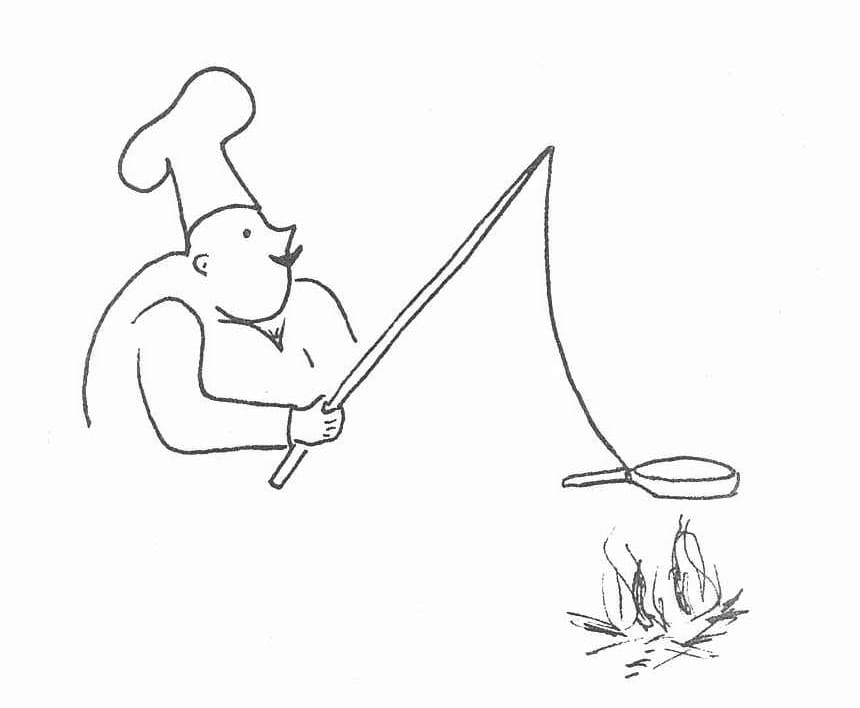
MT SPEC -
A WALK IN THE PAST.
Morning dawned with the prospect of rain which promised a cold and miserable walk - just the weather for a walk in the rainforest! Despite the rain, the trip was to go ahead as planned as the purpose of the trip was to locate, clear and mark some of the Mt Spec tracks.
Three of us Bushies set off early along the timber track from the Paluma Dam Road and were later to meet a party of eight near Gard's battery. It was with a sense of intrigue that we set off down the path of history. After trudging and squelching along the track we located some old tin mines near a clearing before Gard's battery. Some of the holes were quite deep. Walking around the area cast us back to the time when this area would have been bustling with activity..., but, back to reality, the silence and abandonment seemed so final. The area was empty and deserted.
After our bout of exploration, we stood at the creek near Gard's battery and settled down in our raincoats to wait for the other party. Gradually the cold set in and Allan W., who was in high spirits, tried to sing the blues away. The cold was just about to send us packing down to Johnston's clearing where we were to spend the night, when the others arrived. Down the track, one by one, came Cameron and Liz McKenzie from the Paluma Field Study Centre, Paul Ninton( Nat. P. Ranger ), a teacher, four students and Greg ( fellow Bushie ).
That night we all turned in early, driven in by the rain and darkness( due to lack of fire ). The leeches weren't very abundant, but we did come across a carpet snake.
The weather the following day was similar to the previous one and four of us were glad we were leaving that day. The rest of the party would stay another two days. We proceeded along Foxlee's track and then along Bambaroo. One important facet of the day was to locate the 'missing link' - the part of Bambaroo track we'd lost on the previous trip. Cameron and Paul then proceeded to clear the track and tie orange ribbons around trees. This continued all along the track to Shay's clearing. The pace was therefore very slow and towards the end, everyone was tying orange markers around trees. Visibility at Gard's Lookout was non-existent, so we pushed on to Shay's clearing. It was easy to imagine a guest house here surrounded by a flourishing garden, although there were little signs of this now. But for four of us the trip into nostalgia was over and we turned our backs on Shay's and headed for home.
G.L.
Friday lunchtime saw the departure of Allan, Barbara, Liz and Glynis, and as I glanced skyward, I had a notion to tag along. But my sense of adventure prevailed and I sat myself down for a bite to eat.
After lunch the girls and Manual were given the news that they were to lead us back to Johnson's clearing. Well, after the initial shock, they realized that Cameron wasn't going to change his mind, so they reluctantly headed off. With a few tips on navigation from Cameron and the thought of dry clothes, they had no trouble. In fact, it was a bit of a worry trying to keep up for us older folk. After tea we sat around the fire and spun a few yarns (the fire being one very lonely candle!).
On Saturday the weather didn't look too bad so we headed off down Bullocky Tom's for the day. It was quite a pleasant walk with Cameron and Paul stopping occasionally to point out things of interest - birds, fungi etc... From Gold Creek on, the going got a little harder as the ridge was fairly steep and very slippery in places. We spent about two hours clearing one section of the track of wait-a-while and as there was no visible end to it, we decided to stop for lunch. On our way back to camp, Paul suggested that we get an early start as it was obvious that it would take longer to walk out than first predicted.
On Sunday we were up and ready to go by seven and after a check of the area we started our homeward trek. We stopped at Gold Creek for breakfast and from then on the fun began. The track was extremely slippery and steep in parts and the wait-a-while presented its share of problems.
We lost the track when we came out into the open forest, but it didn't prove to be much of a problem as the ridgeline was easy to follow. After a bit of a rest, we headed for the creek. By this time the girls were pretty tired, but still cheerful enough to laugh at one another's misfortune as they slipped and tumbled their way down to the creek.
Once on the creek, it was a simple matter of rock hopping downstream which went more or less without incident except for the odd unscheduled and unwanted swim; and of course the discovery of a small crop of yippy weed which seemed to be coming on fine until Paul and the girls decided to do a bit of weed control. (I've since heard that the local police and ranger went bushwalking in the same area the following week.)
When we finally found the road, Linda and the girls looked relieved and a bit the worst for wear, but they had enjoyed the experience and learnt from it which is what they had set out to do. And myself? Well, it was a great four days, and although it rained most of the time, the knowledge gained was well worth a bit of a soaking. I'm looking forward to more trips in the area.
by Greg Arrowsmith
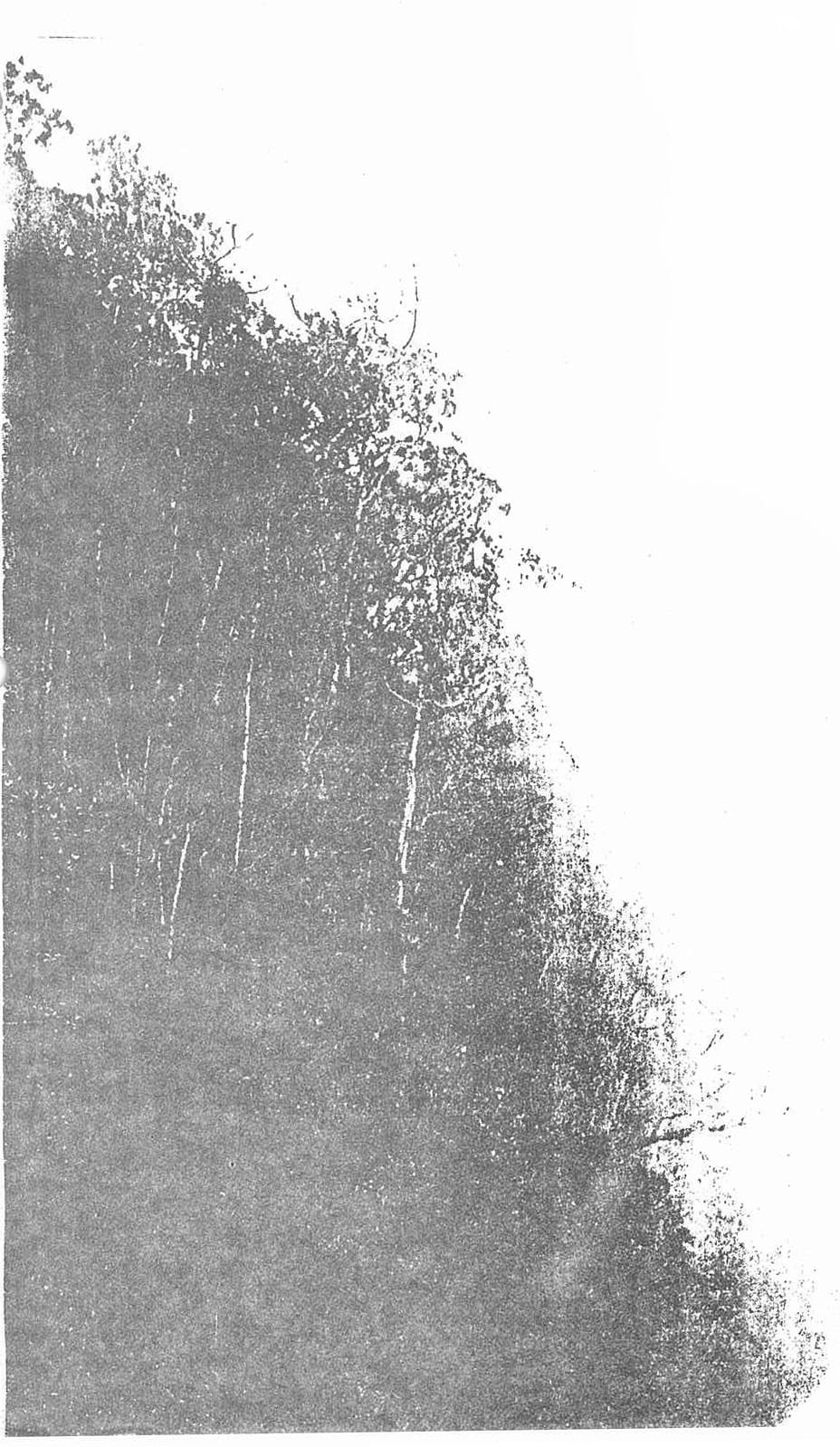
The mist settles in the treetops and hugs the branches as the rain falls -
a light sprinkling that highlights the leaves and sparkles the view to life.
The soft feel of fernery blankets the earth and the fungi and lichen, like palm trees in the desert, form bright patterns against a sea of brown.
Mosses lace the tree-trunks as they stretch skywards to eternity, diffusing the sheet of misty whiteness with elongated silhouettes.
The bird calls echo in the stillness that brings nostalgic memories of years gone by,
But the falling sheet of rain. Casts these memories. Softly to the wind.
G.L.
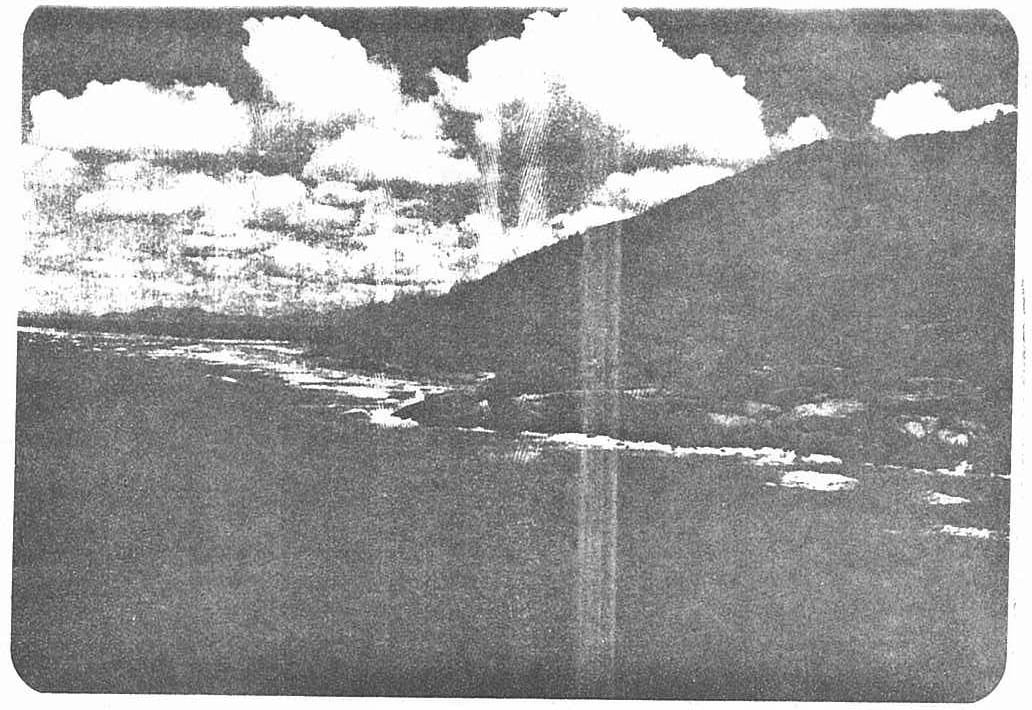
CAPE UPSTART.
Easter Weekend: April 9-12, 1982. by Les Hyland.
The idea seems to have started in Rockhampton! Lou told us that the Rockhampton Bushwalkers were planning a trip to Upstart and somehow we agreed we would go too. Following phone calls to and from Dave Willis, with an eye over our shoulder at ex-cyclone Domenic up off Cooktown, we arranged to meet at "The Cape" station on the morning of Good Friday. Somehow Lou, Marion, Alister and Ben got there a day early and at 04.00 on Friday morning waded the creek and were in Coconut Bay mid-morning. Fourteen more Townsvillites met at Allan Watson's place at or about 06.30 Friday and drove to The Cape. Townsville was first to arrive. Rockhampton slept under the Don River Bridge near Bowen and arrived at 09.00 in Rothery's midi coach. Routes were discussed and we opted for the route on the NW of the creek, they for the causeway and the beach route. We drove on a farm "road" to where the "road" ceased at a rocky creek under Station Hill. Rockhampton had a change of mind and arrived 15 mins later, the bus having negotiated the road even with its small trailer.
Departure was 10.00 following an old four-wheel drive track, somewhat overgrown, but still clearly discernable. We followed this on the flat alongside the creek for some 20 mins and it then ascended sharply with a good viewpoint over the inlet and the creek mouth. The track became progressively more overgrown and eroded as we continued and stopped for a snack on the escarpment of the first summit. From this point, the route of the track over the next spur was fairly obvious. A drop of some 200 ft and a similar or slightly greater rise had us skirting the bluff; track very badly overgrown in places, but still not too difficult to follow. It continues skirting the bluff before dropping into Snug Harbour and we lost it on the descent, continuing along an overgrown creek to the lagoon behind the beach dunes.
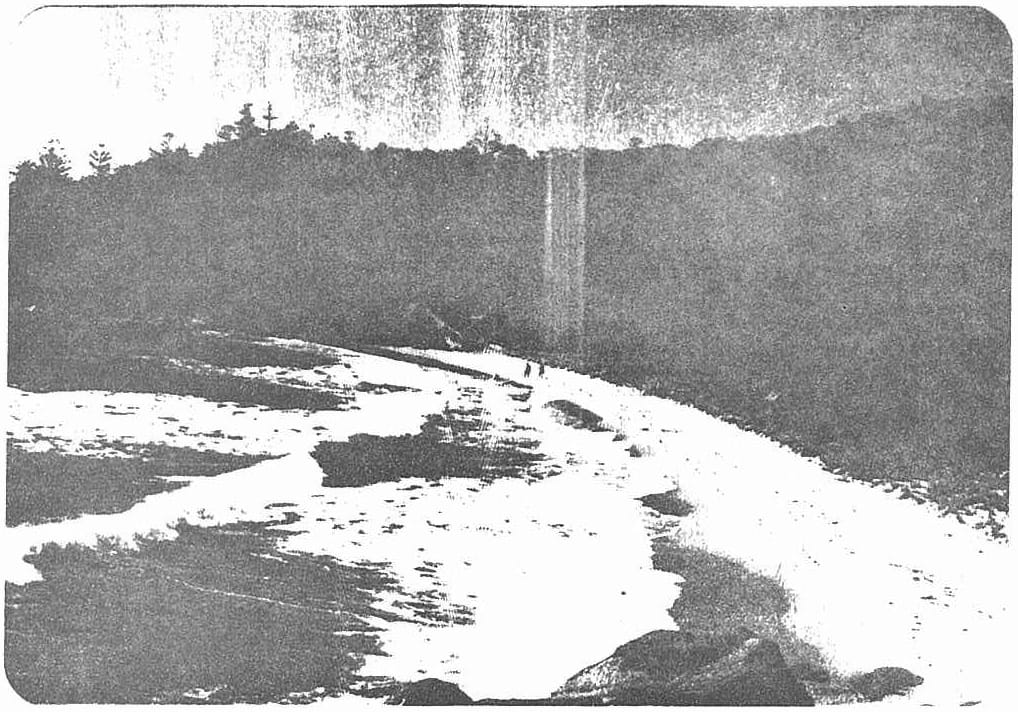
To reach these we skirted the lagoon to the second, larger, creek which, despite lack of rain, was still running sluggishly but yielded a pool of fresh water. We lunched on the rocks on the N of the beach. At this point we had covered only just 4 km in some 2½ hours walking (excluding stops ), but pace was only moderate as despite some cloud cover it was very hot. At Snug Harbour (NB: The names used in this account differ from those on all RASC Maps which have "Coconut Bay" for Snug Harbour, "Kingfish Bay" for Coconut Bay and leave Kingfish Bay unnamed) we were joined by Harry Kershaw who had come across the Cape from Shark Bay by way of Shark Creek and the main creek into Snug Harbour. He reported water in both creeks for most of the two day traverse - he arrived just as we did. Rockhampton group arrived some 30 mins after us having left later.

After lunch we crossed in two groups to Coconut Bay over the 400 ft saddle using the creeks on either side. Going was not difficult, a bit overgrown in spots, route obvious enough and completely dry. Camped in grove of trees at S end of Bay, not far from the creek we had descended. The bay is divided sharply in two by a rocky outcrop. The South end is fine sand, the North end boulders and rounded stones.
Fresh water is only obtainable in the North end about a 20 minute walk each way across the rocky outcrop. Three creeks enter the N end of the bay of which the middle one carried a fair flow. This was walked on Saturday and rises fairly steeply about ½ km from the sea with three good-sized pools suggesting water availability at all times except the very last months of the year.
The parties returned on Sunday and Monday at different times, all by the saddle to Snug Harbour and the rock and beach route to the tidal creek. Four walkers attempted Station Hill via Snug Harbour, its creek and the Northern ridge. The Townsville Group left Snug Harbour at 13.40 on Monday and crossed the tidal creek easily (waist-deep) at 14.20. From the creek the group walked along the beach and took the first 4WD track across the dunes to a causeway just N of The Cape station. It would have been more level but no shorter had we used the next 4WD track which leads directly to the causeway. Walking time from the Creek to the Causeway was about 1½ hours for just 3 km. The party arrived at the causeway at 15.35, collected the cars from the creek and departed the homestead at about 16.15.
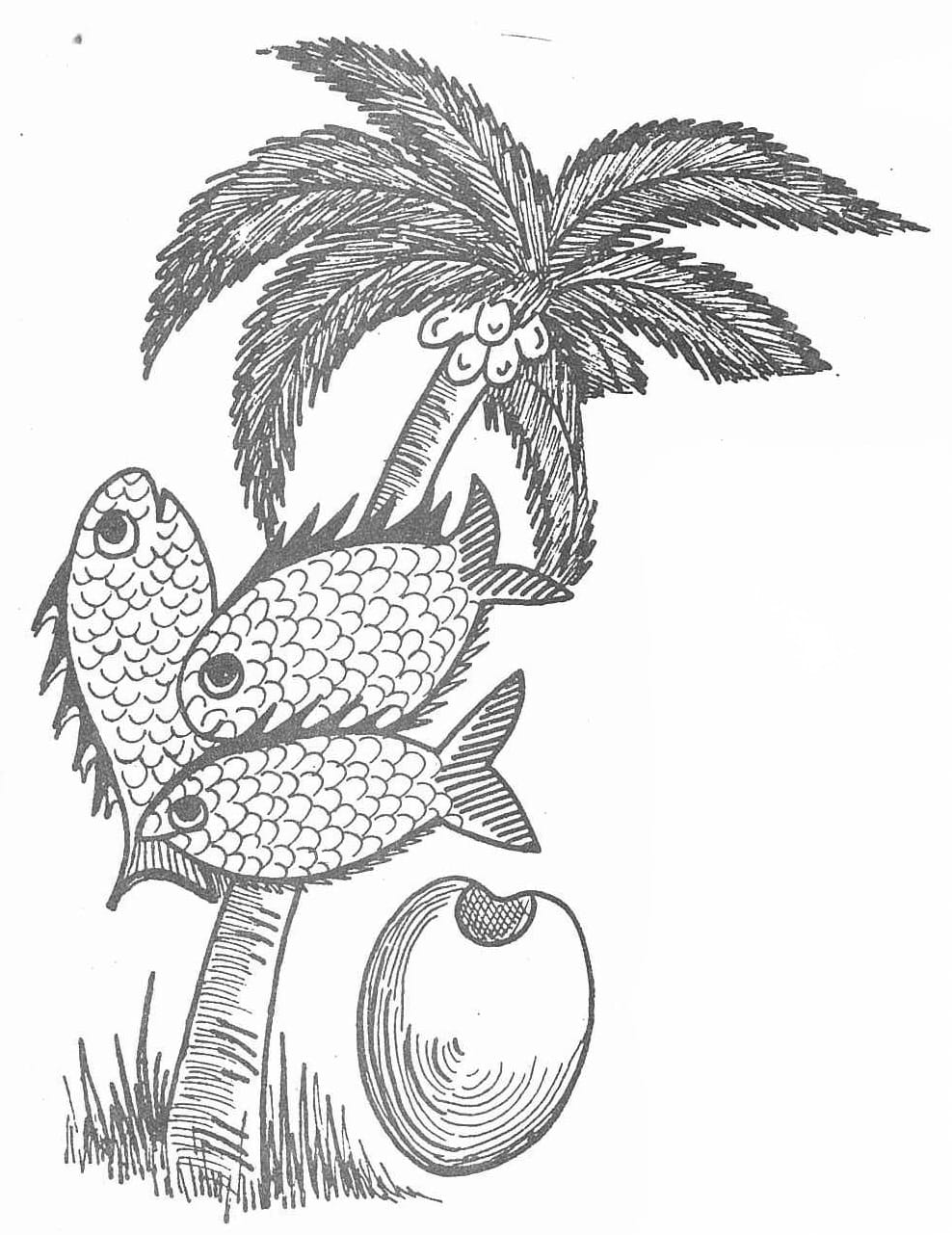
GOOLD, ISLAND OF LIGHTS.
by Harry Kershaw
They were early getting to Cardwell, and I was surprised to see twenty or more, and were soon busy rigging some sort of shelter for the night. We were quite close to the main road, and one member complained that he did not like the lights and noise of the trucks going through his bedroom. A small shower in the wee sma' hours only occasioned slight adjustments.
Dawn was grey, but shafts of pale gold light denoted breaks in the clouds beyond the sombre bulk of Goold Island. A short walk down the jetty and the Club was under way, leaving me to struggle with "Lizzie", the trimaran, through the choppy breakers.
The chugging engines soon made a gap between us: shortly their boat was a dark smudge disappearing round the equally obscure shoulder of Goold, a parting that surprisingly lasted for two days.
The south-easter bore down through the Channel, and I was tossed around before the shelter of Hecate Point, but now the light-shafts grew larger, blue sky appeared, and, in the east, the dark sea became bright green with rather ominous patches of white, as the forecasted "20 knots" tore holes in the cloud cover, and turned the sea into a series of jagged cascades. No hope now of following them to their eastern camp - my only chance was to seek the shelter of Garden Island, where I breathed a sigh of relief after a half hour of crashing foam, and it was very restful to paddle into the quiet waters by the Spit and fix my camp in the shelter of the trees. A humid, cloudy evening when raging Boreas subsided, and far on the western horizon the glittering lights of Cardwell gave assurance of fellow humans.
Next morning, a shower or two held up my resolve to visit the Bushwalkers, so I started rather late. I had paddled only a short way when a great black cloud loomed up. Then a downpour. I gasped as the long spillikins of rain soaked me through, and turned the few metres I could see of the placid water into an enormous "petit point"(a stabbing method in oil painting giving pointed texture, ie. Monet in Water Lily Paintings – Impressionists); but an eerie light, something like that in a shallow cave, pervaded the gloom, and the sun began to wanly shine. I realised there was a rainbow about, but I could not see it, for I was enshrined in it, though there was no Crock of Gold floating on the resplendent sea. I was through the deluge, but my joy was short-lived, for a rude, stabbing wind brought up the prancing white horses again, and I had to return.
That evening, and indeed for the next three, we had a lovely sundown - the weather was settling, for, against the rosy light, was the great whale-back of Bartle Frere : later Orion settled in the west, and, a visitor from another hemisphere, the inverted Great Bear, or Big Dipper was poised to scoop many millions of litres from our northern waters. In the trees fire-flies floated their lights - one landed on my picnic table, giving me a close view - and it was on this night that I ran into the mystic puzzle of the lights. I was walking along the Spit, looking at the coloured twinklings of Cardwell, when I saw several bright spots of phosphorent light at the waters edge. I went down to inspect, and when I looked up, Cardwell wasn't there! Had it been immersed in a tidal wave? Had some cataclysm wiped it out? Was I a candidate for a pillar of salt? I hurried to the top of the Spit and as I went up, only a metre and half of altitude, the lights of Cardwell gradually came back once more. It wasn't an optical illusion, just the curvature of the water, but it did give an instance of how far Cardwell was away.
But Monday was my lucky day, for, in a slight following wind I rode out the south line of Goold, and through the gap between Goold and Mona Islet, where it became dead calm, and the sun shot translucent lights into the yellow-green depths. A few paddle strokes amongst the "Hey-bobs!" and before me were the colourful lights of the tents : then the lights in their eyes, to give a wonderful welcome to the "Ancient Mariner" (I even had a lilo escort.) A glorious "natter" and a "cuppa", and I was assisted out to the brilliant-lit briny again, and a rising south-easterly that wafted me most of the way back.
It was time for them to leave Goold Island and I espied their boat chugging across the bay, glaring white in the declining sunlight. I dressed in white, stepped out as far as I could along the sable rock reef, and, with a hope that they could see me, waved many fond farewells, until the reflected light of their craft was blotted out behind the grey and green flank of Garden Island.
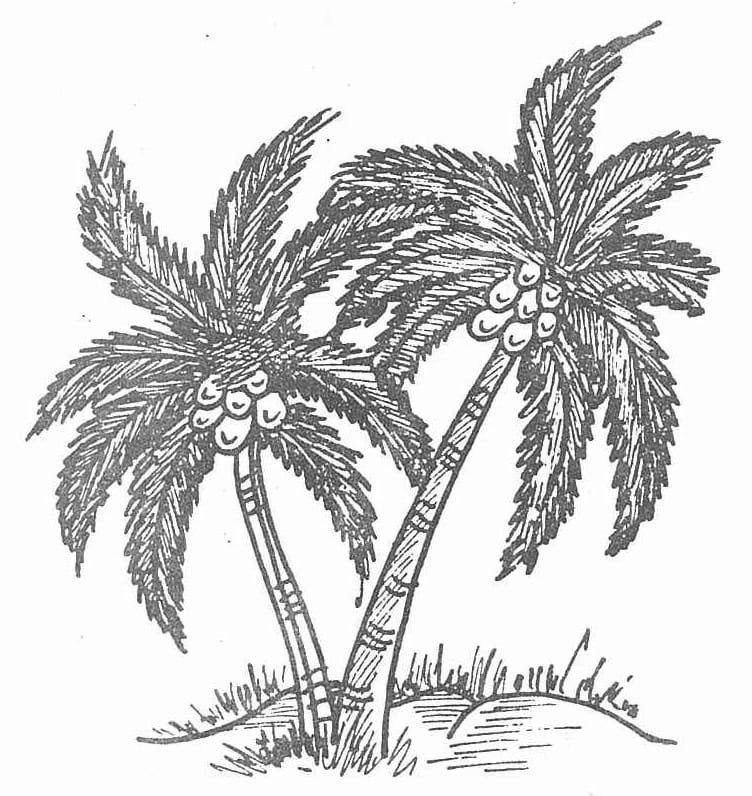
LITTER
Allan Watson
There have been a few trips recently on which the trip leaders have had to carry out tins retrieved from the fire for which no owner could be found. These unfortunate incidents have prompted me to write a few lines on our particular litter problems.
TINS: These must be carried out as buried tins inevitably find their way to the surface, exposed by critters that dig or floods. Washing or burning them out and bashing flat makes for easier carrying. A spare plastic bag for rubbish will keep the inside of your pack clean.
ALUMINIUM FOIL: This will only melt in extremely hot fires, and should be treated as litter to be carried out.
CIGARETTE BUTTS & MATCHES: Both are litter. Used matches and butts are best put in the fire. However, if no fire exists, smokers should be able to take care of butts and matches until a fire is available.
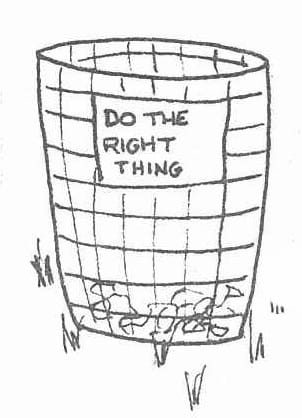
FIRST AID KIT
The following are suggested items for a first aid kit:
- Stingos
- Stingos
- Dressings
- Triangular bandages
- Elastic bandage
- Scissors
- Elastoplas
- Safety pins
- Bandaids
- Asprins
- Needle or tweezers
NOT TO BE REPEATED
by Graeme Standfield
"Well, I'm glad that's over", seemed to be the only utterances heard as we blundered along the track out towards Ollera Creek.
"Next time...there won't be any next bloody time" came a sharp interruption.
It always seems more rewarding to start a report at the finish, particularly if the leader/leaders didn't have to contend with any serious casualties, although Kathy and Lydia might think otherwise.
What's this all about?
It all started as an attempt to reach the peak of Circle View Mountain, which to quote the map, lies on Sheet 8159 (Edition 1), grid reference 260926. It is also somewhere near the head waters of Ollera and Hen Camp Creeks.
Lying half asleep in the back of Allan's panel van early Saturday morning I gradually became aware that it must be raining. The cooling effect of water on the underside of the car floor was having a deleterious effect on my otherwise warm bum.
Having left most of the cars at a pineapple farm, Hen Camp Creek and another at Ollera Creek, those of us not involved in car shuffling wandered desparingly along the Telecom track in drizzling rain. A great start. There's nothing quite like getting wet at the beginning of a weekend walk.
The others caught up and the weather cleared up.
The first few hours or so gave us insight of some of Hen Camp's better sides. Lunch was had at the "deep hole" which was also the lead into a narrow waterfall come mini-gorge. The less intrepid scaled the sides of the gorge, whilst others stepped up the fall itself.
The party of 15 or so, can't remember exact numbers, proceeded up the very pleasant creek whose walls became steeper and the camp sites fewer.
Four o'clock. Eyes began scanning the embankment for a suitable resting place. Still plenty of light, let's push on, there might be a better spot up higher.
A few Gympie started to show as the rainforest crept down and over the narrowing creek.
A reconnaissance party sped off in search of even a hint of flat ground.
Soon came the word that a "suitable" spot was to be had at the summit of a small waterfall. Soon afterwards came the plaintive cry of the first victim of dendrocnide moroides, shortly followed by a second. Kathy and Lydia had both found the same piece of gympie and needless to say spent a restless night.
Still, the rest of us weren't much better off, as bed sites were made against tree roots, rocks etc. At least we had water.
Next morning as the impatient leaders deliberated over our whereabouts everyone else strained packs over aching and stiff joints.
Now, if we follow the creek up a bit higher we should be near the headwater and then its a simple traverse over the undulating plateau to Circle View.
It soon became evident there was nothing simple about it, except our feeble brains. Three hours later after having cut, using garden snippers, a swath through some of the worst lawyer vine yet encountered, someone sighted what must surely be Circle View Mountain. trouble was, it was about 3 km away.
It was quickly calculated that if we continued at our present rate of 2.5 km per 3 hours we might not make it. Not that day anyway. Decision time. No bloody decision required. We're a damned sight closer to our camp than we are to that rotten pyramid.
Then a "discussion" on just where Hen Camp Creek was in relation to our present position.
Majority rule (very democratic) pointed us in a north-east direction straight back down the almost sheer west wall of Hen Camp and into even worse lawyer vine. 15 metres in 15 minutes at one stage despite the steep decline.
We were all very glad to meet up with some previously recognized gympie.
Lunch Day 2 - final day.
From there on nothing much was said at all. At the appropriate point we left Hen Camp, climbed the open saddle between it and Ollera and blundered our weary way in the hot afternoon sun back to the cool and welcome waters of Ollera.
On schedule, Rollingstone beer had never tasted so good!
"Next time.....".
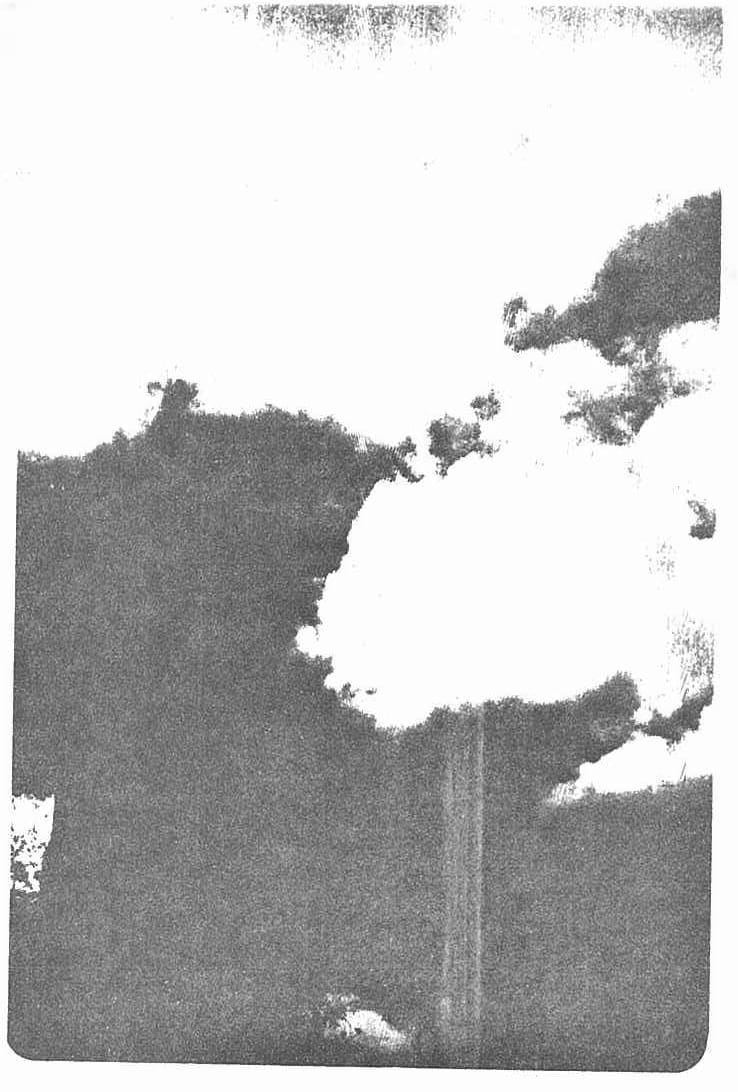
A kaleidoscope of nature's beauty
surrounds
blending with the laughter
of freedom and fun.
The sun wraps its warmth
around me
while the immensity of open spaces
fills me within.
I smell the cleanness
in the fresh air
especially after the rain,
and dwell
in the contentment
of the freedom and solitude
of the bush,
sitting under the stars
by the warm glow
of the campfire,
just being with friends,
or
just
being.
G.L.
